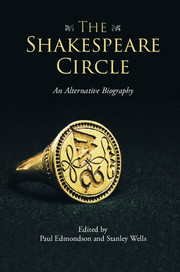Book contents
- Frontmatter
- Contents
- List of illustrations
- List of contributors
- Preface and acknowledgements
- General introduction
- Part I Family
- Part II Friends and Neighbours
- 12 A close family connection: the Combes
- 13 Schoolfriend, publisher and printer Richard Field
- 14 Living with the Mountjoys
- 15 Ben Jonson
- 16 Richard Barnfield, John Weever, William Basse and other encomiasts
- 17 Last things: Shakespeare's neighbours and beneficiaries
- Part III Colleagues and Patrons
- Closing remarks
- Afterword
- Index
- References
14 - Living with the Mountjoys
from Part II - Friends and Neighbours
Published online by Cambridge University Press: 05 November 2015
- Frontmatter
- Contents
- List of illustrations
- List of contributors
- Preface and acknowledgements
- General introduction
- Part I Family
- Part II Friends and Neighbours
- 12 A close family connection: the Combes
- 13 Schoolfriend, publisher and printer Richard Field
- 14 Living with the Mountjoys
- 15 Ben Jonson
- 16 Richard Barnfield, John Weever, William Basse and other encomiasts
- 17 Last things: Shakespeare's neighbours and beneficiaries
- Part III Colleagues and Patrons
- Closing remarks
- Afterword
- Index
- References
Summary
William Shakespeare made his fortune in London during more than two decades as an actor, poet and playwright, but he never kept his primary residence there, as far as we can tell. The few traces of his London residences in the historical record suggest that he moved every few years, presumably renting rooms along the way. Nearly a century after the fact, John Aubrey recorded that Shakespeare had lived in the northern suburb of Shoreditch, location of the Theatre and Curtain playhouses. There is no contemporary record of this, but Aubrey's source was William Beeston, whose father Christopher had performed with Shakespeare in the Lord Chamberlain's Men (Honan 1998, p. 122). Shakespeare appears in the London subsidy rolls as a resident of St Helen's Bishopsgate parish in October 1597 and November 1598. St Helen's was in the north-east part of the city, convenient for walking to the Shoreditch playhouses. Further subsidy records in October 1599 and October 1600 show that Shakespeare had moved across the river to the Liberty of the Clink in Southwark, the location of the newly built Globe playhouse, though he does not appear in the records of the Globe's parish, St Saviour's Southwark (Schoenbaum 1975, pp. 161–3).
We do not know exactly where or with whom Shakespeare lived in St Helen's or in Southwark, but we know quite a bit about one of his next London residences, thanks to a lawsuit discovered in 1909 by Charles William Wallace and his wife Hulda. Probably by 1602, and certainly by 1604, Shakespeare had moved to the parish of St Olave Silver Street, in the northern part of the city inside Cripplegate; specifically, he rented a room in the house of Christopher and Marie Mountjoy, French Huguenot immigrants, on the corner of Monkwell and Silver Streets. We know this because of a lawsuit in the Court of Requests in which William Shakespeare gave a deposition on 11 May 1612. This deposition is of great interest for including the earliest of the six known surviving signatures of William Shakespeare, but it, and the lawsuit of which it is a part, are also very interesting for the details they give us about Shakespeare's life in London in the first decade of the seventeenth century.
Shakespeare's landlord, Christopher Mountjoy, was a Huguenot (French Protestant) tire-maker, or maker of ornamental headdresses for wealthy ladies.
- Type
- Chapter
- Information
- The Shakespeare CircleAn Alternative Biography, pp. 174 - 185Publisher: Cambridge University PressPrint publication year: 2015
References
- 1
- Cited by

